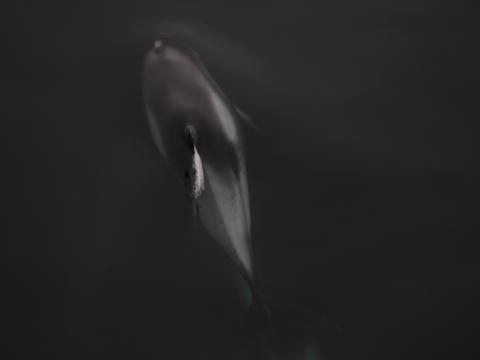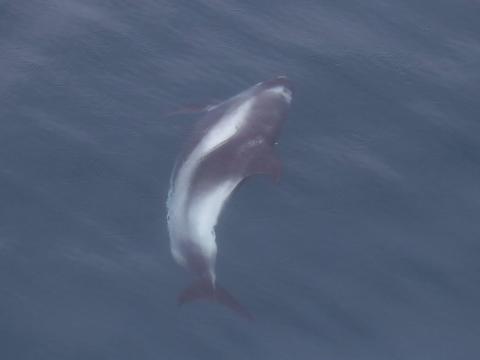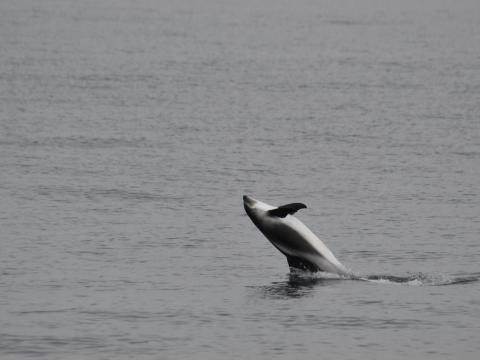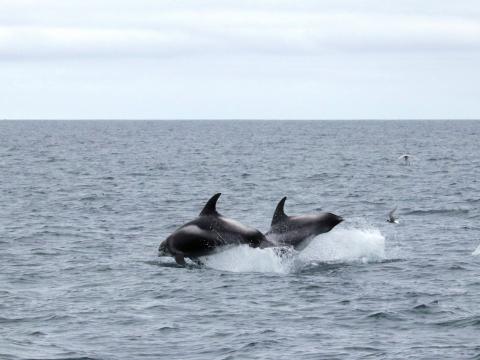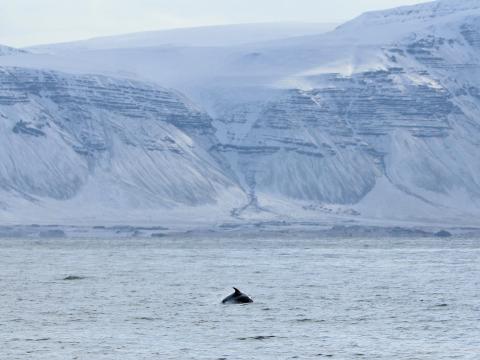WHITE BEAKED-DOLPHIN
The white-beaked dolphin (Lagenorhynchus albirostris) is a marine mammal belonging to the family Delphinidae (dolphins) in the suborder Odontoceti
(toothed whales).
Its scientific name Lagenorhynchus means bottlenose (lageno - flask or bottle, rhynchus - nose, beak) while albirostris refers to the white beak (albus - white, rostrum - beak).
The white-beaked dolphin is a robust species of dolphin with a short beak. Adults can reach 2,5 to 3 m long and weigh 180 to 350 kg. Calves are about 1 m long at
birth and weigh about 40 kg. The coloration is typically black on the back with a white saddle behind the dorsal fin and whitish bands on the flanks that can vary
from shining white to light gray. The belly and the beak normally are white, as the common name implies.
The white-beaked dolphin is endemic to the cold temperate and subarctic waters of the North Atlantic Ocean (meaning they cannot be found anywhere else) and is present in Icelandic waters all year round, especially between the SWand NE coasts. Actually there is a group of about 200 resident animals around this area. Little is known about the species abundance, though the population is estimated to be around 30 000 individuals around the Icelandic waters.
They can also be found on the Labrador Shelf close to southwestern Greenland off the northern and eastern coasts of Britain, and off the coast of Norway.
White-beaked dolphins feed mostly on cod, haddock, and whiting. They are social animals, most commonly found in groups of 9 individuals in average here in
Icelandic waters, but sometimes in much larger associations of over a hundred individuals, hunting, mating and protecting each other. They hunt cooperatively in
a broad front to encircle their prey. They are also social feeders and have frequently been observed feeding with killer, fin, and humpback whales, as well as
other dolphin species.
They use echolocation to navigate, hunt and feel their environment. So, these animals emit sounds and listen to their echoes as the sound waves reflect off
different objects in their surroundings. This processes is called echolocation and basically allows dolphins to send out sound waves that after they hit an object, are
bounced back, allowing them to identify the location, shape, and size of such object. The amount of time it takes for the sound waves to come back help them
to determine the distance.
White-beaked dolphins have grown a fame of being acrobatic. They often approach vessels and bow-ride. They also earned the nickname “jumper”, since they frequently jump out of the water. Although they are normally much slower, they can swim at up to 30 km/h and can dive to at least 45 m depth.
There are no known case of direct attacks on white-beaked dolphins by killer whales (Orcinus orca). However, pods of white-beaked dolphins have been
observed avoiding pods of killer whales. Younger or weakened white-beaked dolphins may be victims of white-shark attacks.
Their life expectancy is about 25 years old. The mating season occurs in July-August with calves being born around the same time in the following year. Females reach their adult size at around five years of age, and are sexually mature at six toten years, while males reach adult size at around ten years, and reach sexual maturity about two years later than females.





